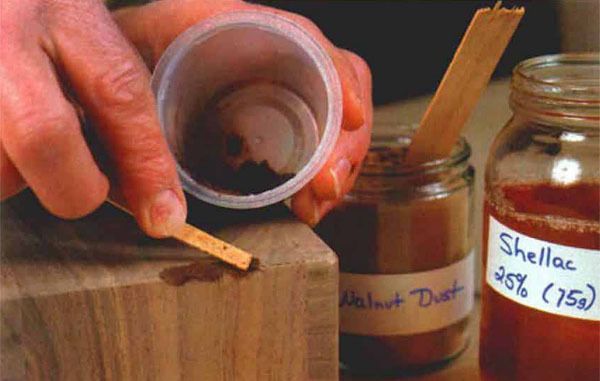Using Wood Putty
Store-bought or homemade, putties can hide defects in wood and mistakes in workmanship
Synopsis: Chris Minick’s early experiences with putty taught him two lessons: store-bought wood putty is never the right color, and the putty always shrinks, even when the label says it won’t. Though defects have decreased in his work, he still uses putty; he’s just gotten better at hiding it. He talks about putty binders and types and what they work well on. He says two-part fillers perform some tasks better, and he explains how to make shopmade putty. He shows how to make a putty repair disappear, too.
In my early woodworking days, a can of wood putty was just as vital as my tablesaw. It seemed as though every project had at least one major putty patch. And regardless of how well I matched the putty color to the wood, a dark blotch always appeared when I stained the piece.
Those experiences taught me two valuable lessons: Store bought wood putty is never the right color, and the putty always shrinks, even when the label says it won’t. My woodworking skills have improved over the years, and obvious defects in my work have decreased to tolerable levels. But that doesn’t mean I don’t use wood putty anymore. I’ve just gotten a lot better at hiding the putty splotch.
The kind of putty I use depends on the type of repair I’m making and the kind of finish I intend to apply later. I’ll often make my own rather than rely on store-bought versions.
The binder determines the type of putty Wood putty or wood dough (not to be confused with woodpore filler) is a thick, pasty material designed to fill nicks, holes or other defects in raw wood. The ultimate wood putty dries quickly, sands easily and takes stain well. Most brands have some of these characteristics, but I’ve yet to find one that satisfies all the requirements.
I classify wood putties in three broad categories based on their binder resins: lacquerbased, oil-based and latex or water-based putties. Lacquer putties (like Bondex Plastic Wood) and latex putties (like Behlen Wood-Fil) are probably the handiest varieties for the woodworker, but each has its own peculiarities.
If quick drying time is important, lacquer-based putties are the obvious choice. After hardening, they are compatible with most finishes. On the downside, they tend to shrink and crack more than-other types of putty, and they take stain poorly.
Latex putties don’t have many of the problems associated with putties made from lacquer. Like lacquer-based putties, latex putties dry quickly. But they don’t shrink much, have excellent compatibility with finishes, sand easily and accept stain fairly well. They’re also easy to tint. They’ve become the standard in my shop. I’ve found that latex putties sold to wood-flooring installers stain better and shrink less than the ones sold to woodworkers. But these putties are hard to find and usually are sold only in quarts or gallons—more than a lifetime supply for many woodworkers. To find these putties in your area, look in the yellow pages under “Floor Materials and Supplies.”
From Fine Woodworking #121
For the full article, download the PDF below:
Fine Woodworking Recommended Products


Diablo ‘SandNet’ Sanding Discs

Bessey EKH Trigger Clamps























Log in or create an account to post a comment.
Sign up Log in